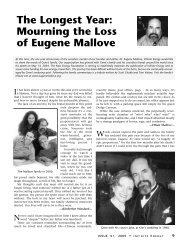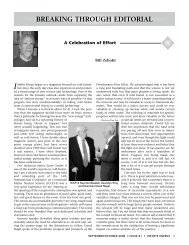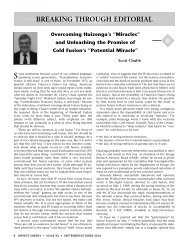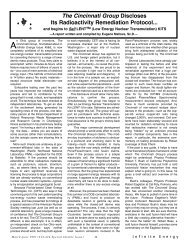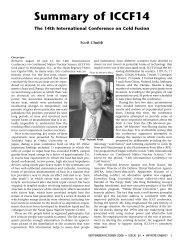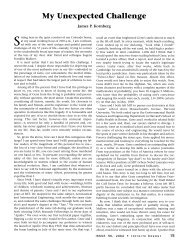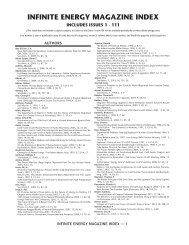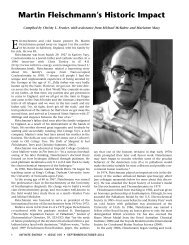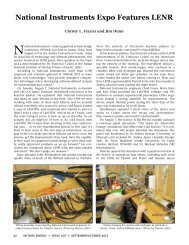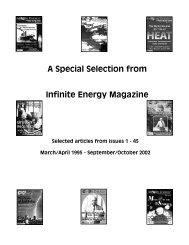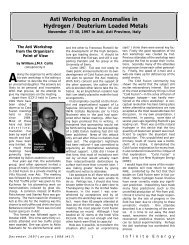MIT and Cold Fusion: A Special Report - Infinite Energy Magazine
MIT and Cold Fusion: A Special Report - Infinite Energy Magazine
MIT and Cold Fusion: A Special Report - Infinite Energy Magazine
You also want an ePaper? Increase the reach of your titles
YUMPU automatically turns print PDFs into web optimized ePapers that Google loves.
Mark Wrighton<br />
Exhibit V<br />
Prof. Morrison’s <strong>Report</strong> to President Charles Vest<br />
October 14, 1991<br />
Professor Morrison’s conclusion that the <strong>MIT</strong> PFC paper “does<br />
not mislead” is completely untenable. It does not square with<br />
the facts <strong>and</strong> it never will.—EFM<br />
<strong>MIT</strong> Department of Physics, Room 6-205<br />
To: Charles Vest, President<br />
From: Philip Morrison, Institute Professor (emeritus)<br />
Assessing the Request for an Inquiry by Dr. Eugene Mallove, made<br />
August 18, 1991<br />
I. My St<strong>and</strong>ing in the Matter<br />
In the presence of clear concern for equity in treatment, I begin by<br />
stating my own qualifications <strong>and</strong> limitations as an assessor.<br />
A theorist with considerable experimental experience--though to be<br />
sure, most of it gained long ago—I think I am qualified as a referee of<br />
the overall methods <strong>and</strong> content of a paper on cold fusion, denoted<br />
Plasma <strong>Fusion</strong> Center PFC/JA-89-34, prepared <strong>and</strong> published by an<br />
<strong>MIT</strong> team from PFC <strong>and</strong> three other <strong>MIT</strong> departments, with sixteen coauthors<br />
(Journal of <strong>Fusion</strong> <strong>Energy</strong>, 9, 133-148, 1990). It is this paper that is<br />
the focus of the substantive issues here, issues that grew in interest well<br />
after the summer of 1990.<br />
I shall not comment on the relationships between PFC research people<br />
<strong>and</strong> the media during the heated summer of 1989, though that is<br />
also part of the request for inquiry. Others may consider them.<br />
The topic crosses disciplines; indeed, that is one of the sources of<br />
trouble. My background in nuclear physics is strong, but I am not an<br />
electrochemist. Much of my general grasp of that specialty has been<br />
gathered during the cold fusion controversy itself within the last two<br />
years. I regard my task as that of an interested scientific reader, but not<br />
one who could propose detailed improvements in the entire experiment<br />
design. The editors who found referees for the paper would probably<br />
seek more than one referee. That understood, I shall support my opinions<br />
with inferences drawn from the paper <strong>and</strong> the criticism of it offered<br />
in Dr. Mallove’s submission.<br />
I know several of the participants in this dispute, none of them better<br />
than I know Dr. Mallove himself. His astronomical specialization <strong>and</strong><br />
interest in science education <strong>and</strong> science journalism have brought us<br />
together over perhaps a decade, before <strong>and</strong> during his stay at <strong>MIT</strong>. Dr.<br />
R. Petrasso of the PFC, a nuclear experimenter, is the second person<br />
involved whom I know rather well. Our interaction extends over a few<br />
years, about a year longer than the cold fusion era. Of course I know the<br />
Provost <strong>and</strong> other more senior members of the team, but not with so<br />
much contact as with Mallove <strong>and</strong> Petrasso. I do not think I hold any<br />
sort of animus for any of these colleagues.<br />
Toward the idea of cold fusion itself I was rather more tolerant <strong>and</strong><br />
optimistic than most physicists. I still believe that there may be a germ<br />
of novelty in some electrochemical phenomenon that is caught up in<br />
this complex system; it is very unlikely, though logically<br />
possible, that new findings, if established,<br />
would turn out to have high economic importance.<br />
They would at most open some way to build a new<br />
battery, possibly a fuel cell.<br />
II. The Substantive Issues<br />
The papers before me are somewhat tangled. The<br />
core of the topic is the publication in the JFE. It is<br />
here, at least in part, in four distinct versions: the<br />
published paper, the MS finally submitted to the JFE<br />
<strong>and</strong> dated July 1990, <strong>and</strong> two partial drafts of that<br />
MS, both by S. Luckhardt of PFC, with signs of much<br />
comment by co-authors. The drafts are dated July 10<br />
<strong>and</strong> July 13, 1989.<br />
With 16 authors, no paper will have a simple history.<br />
This one shows that to be true; the published<br />
version itself is not the same as the MS submitted,<br />
From Philip Morrison’s PBS Television Series<br />
but bears strong mark of editorial changes, in text <strong>and</strong> in figures. All of<br />
this is entirely to be expected.<br />
Two distinct experiments are reported. Phase I was “hastily assembled,”<br />
within days after the initial TV show from Utah. It sought both<br />
real-time nuclear radiation <strong>and</strong> excess electrochemical power. Phase II<br />
was more ambitious, designed as a much more sensitive test of all Utah<br />
claims by rough replication, <strong>and</strong> extended over a couple of months.<br />
All <strong>MIT</strong> results were negative: real-time radiations, atomic products<br />
of fusion within the cells, <strong>and</strong> excess electrochemical power. In addition,<br />
a telling technical criticism of the published Utah-gamma-ray data is<br />
included. I could find no claim by the <strong>MIT</strong> authors that was not well<br />
supported by the data they include.<br />
III. The Ground for Complaint<br />
What then is the ground of complaint? It is not without a logical<br />
basis. The sensitivity of the <strong>MIT</strong> tests for nuclear radiations is improved<br />
by two or three orders of magnitude over the Utah experiments. Even<br />
stronger limits follow from the search for certain fusion product atoms.<br />
In mid-1989 the Utah [people] claimed such products in ample amount,<br />
easy to find. For the most part by 1991 those side effects were no longer<br />
claimed, <strong>and</strong> the main evidence cited was excess power during electrolysis<br />
of heavy water. It is perceived that a new form of fusion might<br />
escape all side branches to deliver energy as lattice heat alone, making<br />
helium as the only product. Even this seems limited by this experiment<br />
to a power down from the Utah claim by a thous<strong>and</strong> or so.<br />
But the Utah investigators are electrochemists, <strong>and</strong> skilled in<br />
calorimetry. In that domain—if not in gamma-ray or neutron detection—they<br />
worked closer to the state of the art. The <strong>MIT</strong> team claimed<br />
an intrinsic sensitivity of their own calorimetry no better than 10 mW,<br />
from the noise visible in all their power measurements. They claimed<br />
overall only a conservative 40 milliwatt sensitivity, about 3% of total<br />
power, allowing for cumulative systematic changes as the open cells ran<br />
for a week or more, losing water <strong>and</strong> gas. (Uncontrolled catalytic recombination<br />
of the oxygen <strong>and</strong> hydrogen produced gas is a source of possible<br />
excess power in the right range.)<br />
The <strong>MIT</strong> estimate of the excess power expected using the scaling methods<br />
of Utah applied to the <strong>MIT</strong> electrodes <strong>and</strong> current was 80 milliwatts.<br />
The point is clear: the expected nuclear products are excluded by the <strong>MIT</strong><br />
paper at a level down from the Utah claims by several orders of magnitude.<br />
But <strong>MIT</strong> could limit the excess calorimetric power only by less than<br />
one order of magnitude, a factor somewhere between two <strong>and</strong> five. That<br />
entails much closer scrutiny of the much less precise results of calorimetry.<br />
The hope of the optimists—Mallove is not the only one—is that the<br />
assumptions, plausible as they are, that fusion has to proceed at least in<br />
part along known channels, is somehow wrong. Heat is the most general<br />
(<strong>and</strong> desired) product. (Helium appears to me almost equally<br />
robust; if it is not made, the process is hardly fusion. It is possible that<br />
helium is lost from the cells.)<br />
IV. The Two Drafts Differ<br />
The focus of Mallove’s criticism is on a difference between the two<br />
partial <strong>MIT</strong> draft manuscripts. In the earlier one (Attachment 5) the<br />
excess power is corrected by a simple linear fit for long-term drift <strong>and</strong><br />
plotted, with many points, both for heavy water <strong>and</strong> the light water<br />
control cell. I measured on the MS graphs the mean<br />
excess power over time for both cells, using for each<br />
the area of the region between the locus of zero<br />
power <strong>and</strong> the noisy data.<br />
The mean power excess: heavy water cell +15 milliwatts;<br />
light water cell + 4 milliwatts<br />
Neither result is significant, for the claimed power<br />
error is 40 mW, <strong>and</strong> even a less stringent definition<br />
would put the error at 20 or 30 mW.<br />
The 13 July draft fits a less simple, least square correction<br />
to eliminate the drift, <strong>and</strong> ends up with a value<br />
I did not measure, but one visibly close to zero for both<br />
cells. The claimed error is not reduced; such small variations<br />
in the mean are simply not significant, whether<br />
they turn out zero or not.<br />
The first hint of a small positive excess power in the<br />
heavy water cell is a source of encouragement for<br />
47 <strong>Infinite</strong> <strong>Energy</strong> • ISSUE 24, 1999 • <strong>MIT</strong> <strong>Special</strong> <strong>Report</strong>



